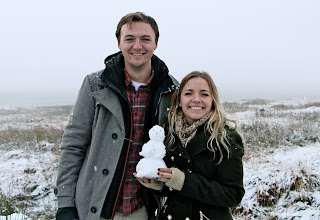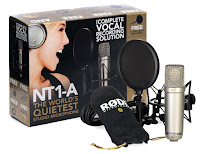 Hi there! This is Brittany Ragan, the fourth (and favorite) child of Theresa Ragan. I am a freelance graphic designer based in sunny Santa Barbara.
Hi there! This is Brittany Ragan, the fourth (and favorite) child of Theresa Ragan. I am a freelance graphic designer based in sunny Santa Barbara.
I’m here to report on my journey so far with becoming an audiobook narrator/editor. I’m working in tandem with my boyfriend, Dillon Yuhasz. A little bit about Dillon: He majored in theater and has a real knack for doing character voices. You should hear his Frank Underwood impression—it’s like I’m dating Kevin Spacey.
Anywho, when my mom asked us to record the audiobook for Dead Man Running, Dillon and I were very excited and quickly agreed to help. The plan was for Dillon to narrate and for me to edit. We thought it would be easy to figure out what equipment we needed and how to get started… but boy were we wrong! There was little to be found on this subject on the Internet, which is what inspired me to write this post. If you know of any useful sites or How-To-Audiobook articles PLEASE share in the comments because I would love to read them.
These are the steps that Dillon and I took in order to get our audiobook narration business going:
STEP ONE: LISTEN TO AN AUDIOBOOK
Get to know what different narrators sound like. We listened to Stephen King’s IT and absolutely loved the narration by Steven Weber. We also surveyed clips of other audio books and found some narrations that we... didn’t like so much. It’s good to figure out what things you like and don’t like as a listener so you are educated when getting into audiobook narration.
STEP TWO: BUY THE GOODS
 The Microphone
The MicrophoneWe knew we needed a good microphone, so we talked with our friends who had gone to school for production and read reviews of various microphones and packages online. We finally settled on the Rode NT1A Anniversary Vocal Condenser Microphone Package for $229 on Amazon. It comes with the mic, a mic dust cover, a pop shield, a shock mount (NOT A MIC STAND), and a 20ft microphone cable.
Mic Stand
We also bought a decent desk mic stand, for $12.33. It’s sturdy and has a heavy base, which is nice because it stays in place.
We also bought a decent desk mic stand, for $12.33. It’s sturdy and has a heavy base, which is nice because it stays in place.
Audio Interface
We got the Focusrite Scarlett 2i2 USB Recording Audio Interface for $150. You need an audio interface. This turns the analog sound from the microphone into digital information that is read on the computer. While your computer most likely has a sound card of its own, an audio interface is designed to operate with lower latency, or lag, than the sound card and is necessary for good audio recording.
We got the Focusrite Scarlett 2i2 USB Recording Audio Interface for $150. You need an audio interface. This turns the analog sound from the microphone into digital information that is read on the computer. While your computer most likely has a sound card of its own, an audio interface is designed to operate with lower latency, or lag, than the sound card and is necessary for good audio recording.
Audio Editing Software
I am a graphic designer so I use Illustrator, Photoshop and InDesign on the daily. Because of this I have an Adobe Creative Cloud subscription, which includes the program Adobe Audition. You need audio editing software so you can edit and export the video. There are many programs out there, but Audacity is a free program you can download and use for editing as well. If you do not have experience with using an audio editing platform—Have no fear! Dillon and I didn’t either. Whichever program you choose I recommend using YouTube to look up tutorials for your specific audio editing software on how to record and edit the audio. One YouTube video that I used to learn more about Adobe Audition can be found right here.
I am a graphic designer so I use Illustrator, Photoshop and InDesign on the daily. Because of this I have an Adobe Creative Cloud subscription, which includes the program Adobe Audition. You need audio editing software so you can edit and export the video. There are many programs out there, but Audacity is a free program you can download and use for editing as well. If you do not have experience with using an audio editing platform—Have no fear! Dillon and I didn’t either. Whichever program you choose I recommend using YouTube to look up tutorials for your specific audio editing software on how to record and edit the audio. One YouTube video that I used to learn more about Adobe Audition can be found right here.
STEP THREE: SET UP A SPACE FOR RECORDING
FIND A QUIET PLACE. There are plenty of articles out there discussing the do’s and don’t of recording audio. My favorite tips were:
- Steer clear of unnecessary noises. Turn off appliances, shut windows and doors, and try to avoid hard surfaces for fear of the sounds reflecting.
- Do not record in the middle of a room. Something known as “standing waves” exist and frequencies can build up and add unwanted sound.
- Have a chair that you can sit comfortably in. As the narrator, you’ll want to make sure you can be comfortable in order to be on your A-game.
My apartment isn’t exactly the ultimate space to use as a recording studio but we found that the quietest room was the bedroom. We set up two foldable tables and a chair and made a makeshift recording studio between our closet and bed.
STEP FOUR: RECORD
Dillon works full-time as a teacher, so he doesn’t have a lot of extra time. He’s been recording every Saturday for a few hours so we can get this book done. His tips on recording include:
- Do any type of vocal warm ups. A few examples can be found here.
- Don’t worry about messing up—that’s when you will mess up!
- Too slow is better than too fast. Work on timing and try to keep a good, listenable pace.
- Read from your kindle, phone, or computer. You won't want to edit out the sound of pages turning.
- Have a glass of water nearby and stay hydrated.
- Make sure you are engaged in the story—you can’t just read it. You need to understand what the story is about so you can convey the emotion that the author is going for.
STEP FIVE: EDIT
Dillon has been editing as he records. If he makes a mistake he just deletes and re-records. When he’s done, I listen to the tracks in search of any noise that isn’t a part of the book (like a slight creak in the chair, outside traffic, or anyone moving around in the other room).
MORE STEPS TO COME.
I’ll be writing Part Two to continue this post once Dillon and
I have finished recording the audio, exported, compiled,
and uploaded the audio files.














